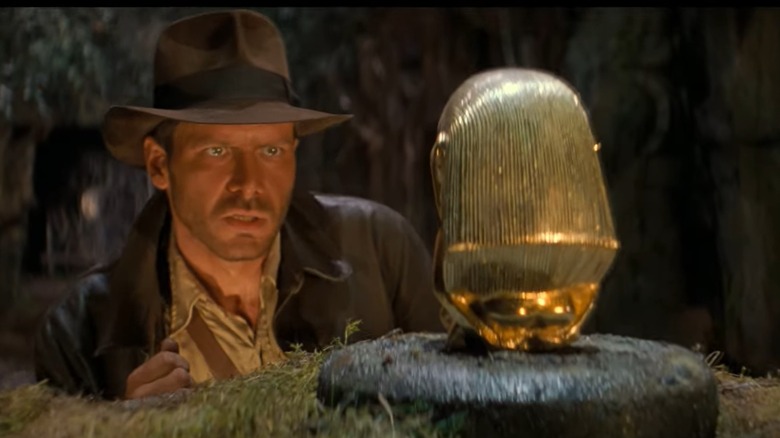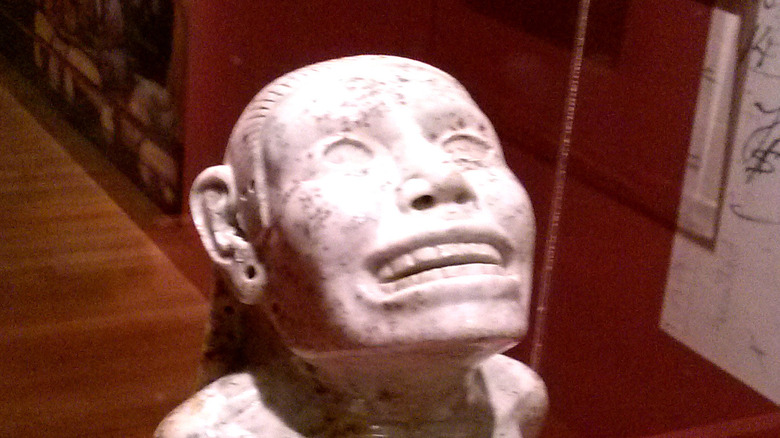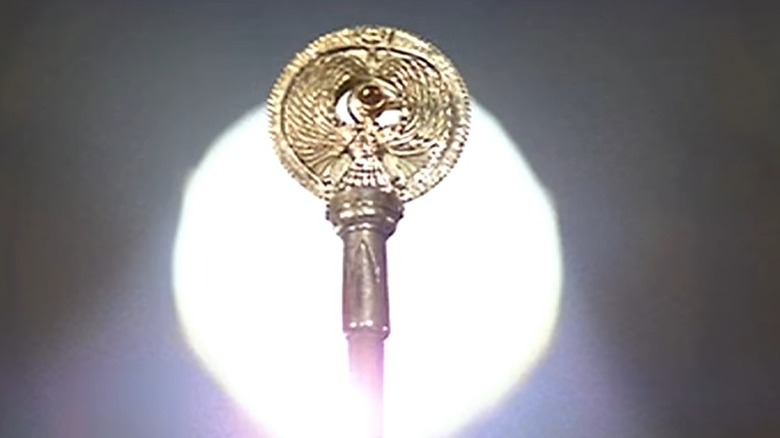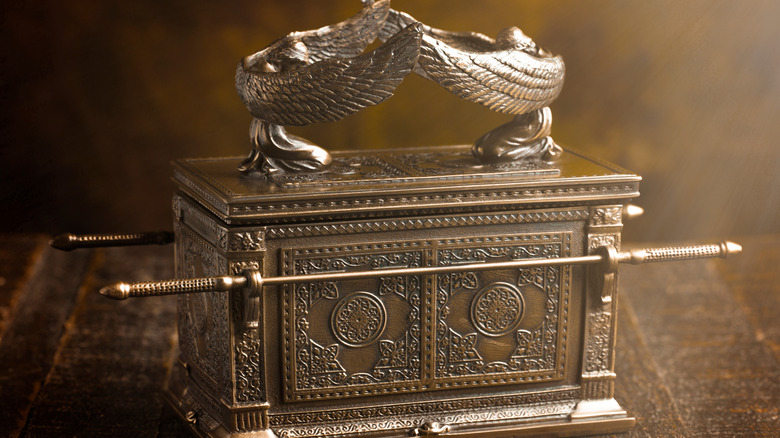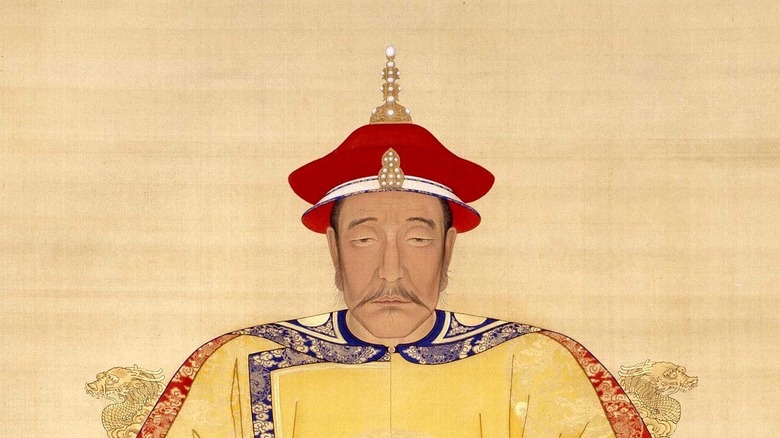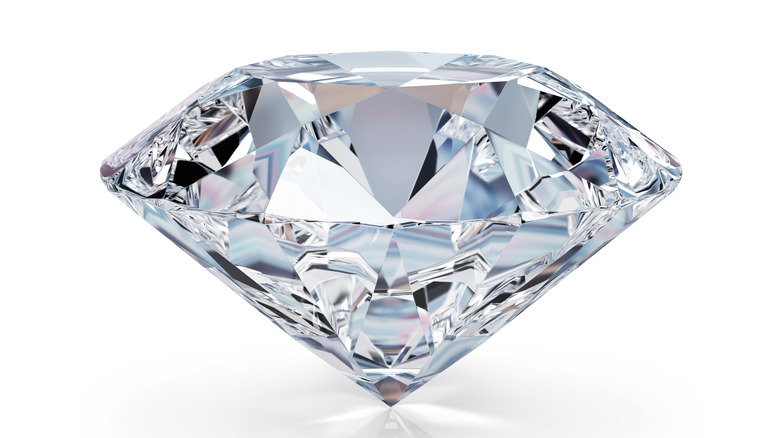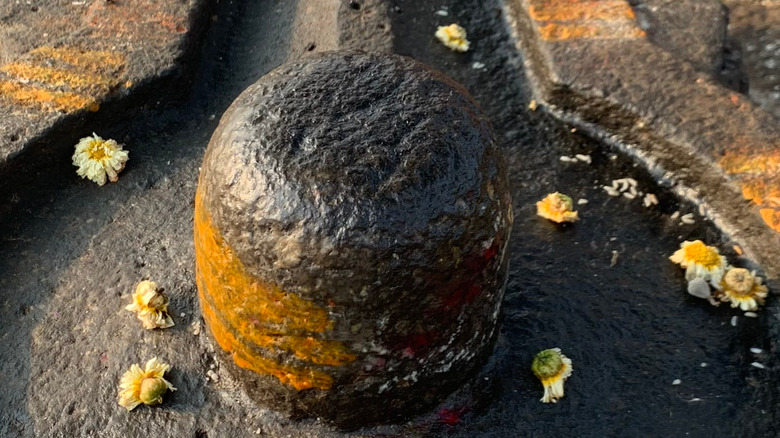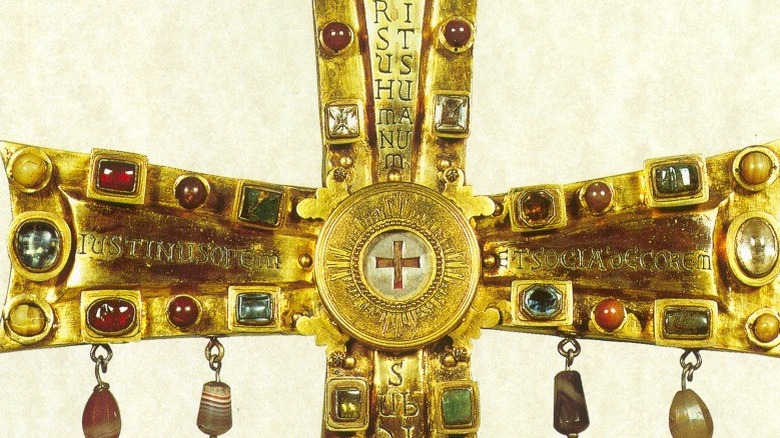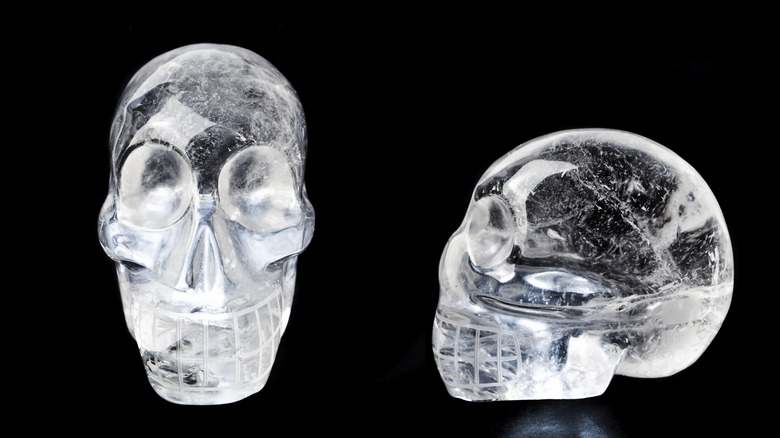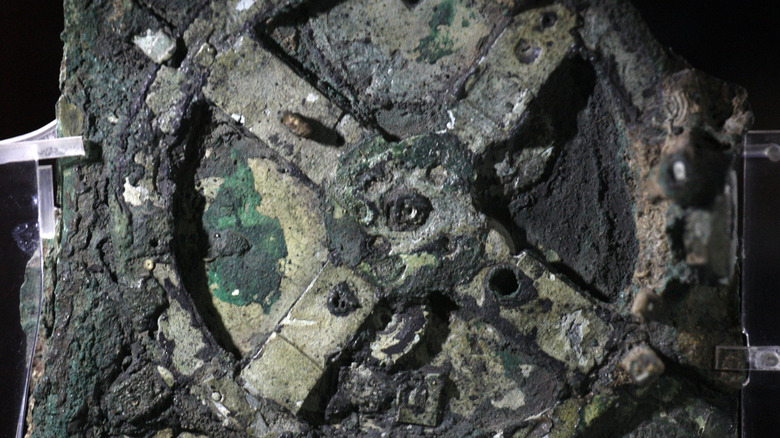The Real Histories Behind These Indiana Jones Artifacts
When a certain John Williams score blares from the cinema speakers, coupled with the crack of a whip, thrill and wonder fills the air as viewers ponder which ancient artifact Indiana Jones will be pursuing in his latest adventure. Indy has been gracing the silver screen since 1981 with the rollicking action flick "Raiders of the Lost Ark," and has continued — with some interruptions — until 2023's upcoming "Indiana Jones and the Dial of Destiny."
Harrison Ford, who stars in the titular role as the intrepid and not-afraid-to-fight-Nazis archaeologist, will be donning his fedora for reportedly the last time. However, even though Indy may be getting long in the tooth, the general concept of any Indiana Jones movie is the same: relentlessly pursue an ancient artifact.
Indiana Jones movies all contain a plot McGuffin, this being an artifact that the hero wants to hand over to a museum, and the movies demonstrate that Indy will stop at nothing to get his hands on it. While the payoff in the movies is thrilling, such as watching faces melt, many often leave these films wondering about the historical authenticity of the featured artifacts. Ever wanted to take a deep dive into each of the artifacts which appear throughout the Indiana Jones films to examine their real history — if any? Pull out your bullwhip, and let's get ready to hop on the Pan Am of your imagination, in an exploration of the real history behind the artifacts of Indiana Jones.
Chachapoyan fertility idol
In the iconic opening of Indy's first outing in "Raiders of the Lost Ark," the intrepid archaeologist penetrates a booby-trapped laden temple in the jungles of Peru, risking life and limb. His goal is a fabulous golden idol.
While the actual statuette used in the filming is not a real golden idol, it does have a historical basis, although it is dubious. The movie idol was based on the real-life "Dumbarton Oaks Birthing Figure," which is kept at a museum as part of the Robert Woods Bliss Collection of Pre-Columbian Art, at the Dumbarton Oaks estate in Washington, D.C. This 8-inch scapolite figure is thought to be Aztec in origin and depicts a woman in pain giving birth. For the purposes of the film, the producers only depicted the face in their version of the idol.
However, the real figure may not be authentic. Its verifiable history goes to 1899, when it was reported to be at a Parisian antique shop. From there, it passed hands until it came to Dumbarton Oaks. Since then, its true provenance has been questioned. Some analyses have argued that it shows evidence of being fashioned by tools from the 19th century, and may be only what an artist considered to be ideal Mesoamerican art. Whether fake or real, this statuette has now had a lasting impact on popular culture.
[Featured image by Madman2001 via Wikimedia Commons | Cropped and scaled | CC BY-SA 3.0]
Headpiece to the Staff of Ra
In "Raiders of the Lost Ark," Indy's relentless pursuit of the ark led him to acquire an Egyptian artifact from former paramour Marion Ravenwood (played by Karen Allen), called the "Headpiece to the Staff of Ra." In the movie, the headpiece is a circular disc, containing a bird figure with a red crystal in place of an eye.
The headpiece also has information on the length of the staff which, fortunately for Indy, his Nazi competitors only managed to partially find. Indy then uses the artifact to find the location of the ark of the covenant by attaching it to a staff and then, in a chamber called the Map Room, places it so that the sun strikes it. The light passes through a gem in the artifact and creates a laser-like beam, revealing the location of the well of the souls where the ark is located.
The headpiece is an awesome artifact, but it is completely fictional. Lois H. Gresh, in tackling this topic in "Why Did It Have to Be Snakes?," points out that pharaohs and other ancient Egyptians had staffs and they also worshipped the sun god Ra, who also was symbolized by birds. However, there is no evidence for a staff of Ra that emits laser beams. So while this is a great movie prop, there is no other history behind it other than a brilliant brainstorm from the scriptwriters.
The Ark of the Covenant
The ark of the covenant is the main, Nazi-face-melting artifact in "Raiders of the Lost Ark," which the movie does to some degree get right, and in other respects gets wrong. According to the biblical account, the ark is where the Israelites kept the two tablets of the Ten Commandments given to the prophet Moses. The movie does well in matching the biblical description, given in detail in the Book of Exodus.
In "Raiders," the story is that the ark was captured by the Egyptian pharaoh Shishak and kept in Tanis, which was then consumed by a year-long sandstorm — as the character Marcus Brody says in the movie, "Wiped clean by the wrath of God." The only support for this story is from the first Book of Kings, which notes that the Egyptians brought treasure with them, but not necessarily the ark.
As for Tanis, there is no evidence to support it being where the ark was hidden, although Tanis is just as exciting as a major archaeological dig site in Egypt. Furthermore, the bible's chronology does not line up with Tanis, the latter being too old to be associated with the ark. As for the eventual fate of the ark, there are several theories on its resting place, ranging from Rome to Mount Nebo to Ethiopia. However, it is almost certainly not in a giant warehouse, as depicted at the end of the movie.
The Ashes of Emperor Nurhachi
"Indiana Jones and the Temple of Doom" opens with a scene in Shanghai where Indy swaps an artifact in a deal with a gangster that turns deadly. The artifact is a jade urn that purportedly contains the ashes of Emperor Nurhachi. The movie gets it right in that there was a real Emperor Nurhachi (1559-1626), who was one of the founders of the Qing (Ch'ing), sometimes called the Manchu, dynasty. This emperor was battle-hardened, since much of his career was spent trying to wrest control of China, then ruled by the Ming Dynasty. Indeed, Nurhachi died of wounds from battle.
So was Nurhachi cremated and put into a coveted jade artifact? It does not seem likely. "Eminent Chinese of the Ch'ing Period" by Arthur W. Hummel states: "Nurhachi was buried east of Mukden in the mausoleum known as Fu-ling." Modern travel guides still refer to the emperor being there, so there is no reason to believe that his ashes were in a jade urn. Yet perhaps the most enduring question for Indiana Jones fans has been posed by Lois H. Gresh in "Why Did It Have to Be Snakes?" when she asks: "Why would Indiana Jones hand over the real ashes to a gangster? How would the gangster know the real ashes from other ashes?"
The Peacock's Eye Diamond
In "Indiana Jones and the Temple of Doom," the hero trades the ashes of the Emperor Nurhachi with the gangster Lao Che for one of the biggest diamonds ever to grace the silver screen. In the scene, there is no mention of what the diamond is, which leads the viewer to believe that Indy is simply seeking to make a profit over the black market trade of an ancient artifact. However, Lois H. Gresh in "Why Did It Have to Be Snakes?" explains that the diamond is identified in the "Young Indiana Jones" series as the Peacock's Eye Diamond, which once belonged to Alexander the Great. However, no such diamond historically existed.
Indy's character seems to take a darker, more mercenary turn in "Temple of Doom." Heck, in the scene in question, Indy threatens the heroine Willie Scott's life with a large fork. It has been widely reported that this dark turn was attributable to George Lucas getting divorced, and director Steven Spielberg also having relationship problems. This turned off a section of the fanbase, who wanted the fabled archaeologist to be adventuring for the right reasons. This has led writers such as Edwardo Pérez, in the anthology "Indiana Jones in Philosophy," to contend that the additional fictional backstory of this immense diamond was created to redeem the character.
The Sankara Stones
The central artifacts in "Indiana Jones and the Temple of Doom" are several stones called the "Sankara Stones." These stones purportedly have mystical abilities, with power over the Earth itself. In the movie, one of these stones, called the Sivalinga, is stolen by the chief villain, the Thuggee priest Mola-Ram, who uses it for his own evil schemes. Indy then fights to get the stone back to restore prosperity to the Indian village from whence it was taken.
Cutting to the chase, there were no real Sankara Stones, but there was a real-life inspiration for them; the Shiva Lingam. These are explained in a bit more detail by Athena Perrakis in "Crystal: Lore, Legends, and Myths," who describes how these stones are a type of sculpture that dates back to the Vedic Period (circa 1500 B.C.). These crystals, which are found along the Narmada River, are egg-shaped and considered hallowed to the god Shiva as a symbol of fertility. However, they do not have magic powers.
Cross of Coronado
At the beginning of "Indiana Jones and the Last Crusade," a teenage Indiana Jones successfully steals a historic crucifix away from a band of graverobbers, only to be forced to hand it over. He manages to obtain it years later, in a struggle where he quips, "It should be in a museum."
In the "Indyverse," the jewel-encrusted cross was owned by the Spanish conquistador Francisco Vázquez de Coronado, who received the item from the conquistador Hernán Cortés in 1520, according to Vice. This cross is entirely fictional, but it may have been inspired by the Crux Vaticana (also called the Cross of Justin II), currently housed in St. Peter's Basilica in Rome. This real-life cross purportedly holds one of the fragments of the cross upon which Jesus was crucified. This artifact dates to the time of the Byzantine emperor Justin II, who gave it to Rome as a gift in the sixth century. It has recently been restored to its Byzantine glory.
So while Indiana Jones's Cross of Coronado is certainly interesting, the Crux Vaticana is even more so, and more in line with the themes of the "Last Crusade."
[Featured image by Gfawkes05 via Wikimedia Commons | Cropped and scaled | CC BY-SA 4.0]
The Holy Grail
The Holy Grail is the featured artifact in "Indiana Jones and the Last Crusade." In the movie, the grail is purported to be the cup kept by Joseph of Arimathea, which was used by Jesus at the Last Supper and also collected his blood while he was on the cross. In the film, it was thought that the grail would grant immortality to a person who drank from it.
The Holy Grail is not a verifiable historical artifact, although it is the subject of many myths and legends. Most folklore surrounding the grail developed during the Middle Ages, and eventually became very closely tied with Arthurian tales. Indeed, most of those legends seem to be related to ancient fertility rites and beliefs, where the grail also represented the health and vitality of the land.
In reality, no one knows if this cup exists or existed, and many scholars would contend that it does not. Still, because of the alluring legend of the grail, and not to mention popular interest in it, such as in the film "Monty Python and the Holy Grail," it is a natural McGuffin for an Indiana Jones film.
The Crystal Skull of Akator
Instead of battling Nazis in "Indiana Jones and the Kingdom of the Crystal Skull," a more senior Indy and Mutt Williams (played by Shia LaBeouf) go to Peru to seek the legendary Skull of Akator, imbued with supernatural powers. The crystal skull in this 2008 film is inspired by real objects purportedly from Mesoamerica. These crystal skulls have been featured in museums throughout the world, from small, amulet-sized skulls to those the size of bowling balls.
These were thought to be ancient Aztec artifacts, but modern analysis has shown that the actual stone originated from Brazil — and that they were cut by modern rotary tools to boot. It seems that these skulls first came onto the scene in the 1800s, and were crafted by a French antiquarian named Eugene Boban, who was obsessed with Aztec art. Since he was considered an expert in Mesoamerican art, until recently his work was accepted and happily purchased by various collectors and museums.
So while these skulls are probably fakes, they still continue to attract attention. And not all collections are convinced they are fake, including the British Museum, which writes: "The question remains open."
The Dial of Destiny
The latest installment of the Indy saga is "Indiana Jones and the Dial of Destiny." In this final outing of Harrison Ford as the titular character, he is seeking the "Dial of Destiny," which may be based on the real-life Antikythera Mechanism. This artifact, first discovered in 1901 near the island of Antikythera in the Mediterranean, is an ancient Greek object from the Hellenistic period, dating to about 100 B.C.
What is most interesting about the artifact is its complexity. Comprised of at least 30 known gears, it is thought to be a tool that helped ancient astronomers make predictions about the stars. It seemingly has the ability to forecast, among other things, lunar and solar eclipses, and may be the world's first mechanical computer. Yet this is purely speculative, since while scholars may guess at its exact purpose, it is yet not fully understood. In this way, the Antikythera Mechanism makes for a perfect Indiana Jones artifact — with or without face-melting abilities.
